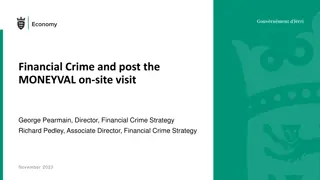Maximizing Expenditures for 2024-2027 Financial Period
Explore WMO's Strategic Plan 2030 and objectives for the 76th Executive Council session, focusing on enhancing services, Earth system observations, and climate information. Highlighted areas include sustainable infrastructure investment, policy-relevant science, and inclusive participation. Embrace the core values of collaboration, diversity, and transparency to achieve resilience against extreme weather events and promote sustainable development globally.
Download Presentation
Please find below an Image/Link to download the presentation.
The content on the website is provided AS IS for your information and personal use only. It may not be sold, licensed, or shared on other websites without obtaining consent from the author. Download presentation by click this link. If you encounter any issues during the download, it is possible that the publisher has removed the file from their server.
Presentation Transcript
Maximum Expenditures for the nineteenth Financial Period (2024-2027) 76thSession of the Executive Council EC-76/Doc. 5 and EC-76/INF. 5 27 February 2023
WMO Strategic Plan 2030 A world where all nations, especially the most vulnerable, are more resilient to the socioeconomic impact of extreme weather, climate, water and other environmental events, and empowered to boost their sustainable development through the best possible weather, climate and water services VISION Preparedness for, and reducing loss of life, infrastructure and livelihood from hydrometeorological extremes Climate-smart decision-making to build resilience and adaptation to climate risk Socioeconomic value of weather, climate, hydrological and related environmental services OVERARCHING PRIORITIES Accountability for results and transparency CORE VALUES Collaboration and partnership Inclusiveness and diversity LONG-TERM GOALS 3 Organization 5 1 2 4 Services Infrastructures Science and Innovations Member Services Smart Better serve societal needs Enhance Earth system observations and predictions Strategic realignment of WMO structure and programmes Advance targeted research Close the capacity gap 1. National multi-hazard early warning/alert systems 1. Acquisition of Earth system observation data (WIGOS) 1. Advance scientific knowledge of the Earth system 1. Enable developing countries to provide and utilize essential services 1. OptimizeWMO constituent body structure STRATEGIC OBJECTIVES 2. Policy- and decision- supporting climate information & services 2. Access to, exchange and management of Earth system observation data and products (WIS) 2. Enhance science-for- service value chain to improve predictive capabilities and analysis 2. Strategic partnerships 2. Develop and sustain core competencies and expertise 3.Advance equal, effective and inclusive participation 3. Hydrological services 3. Scale up partnerships for investment in sustainable cost- efficient infrastructure and service delivery 4. Decision-supporting weather information & services 3. Access to and use of numerical analysis and Earth system prediction products 3. Advance policy- relevant science 4. Environmental sustainability 5. Changes in the cryosphere and downstream impacts Focus areas for 2024-2027 2
WMO STRATEGIC PLAN OVERARCHING PRIORITIES 2020 2023: LAYING THE GROUND 2024 2027 SCALING UP Early Warning Systems for All Enhancing preparedness and reducing loss of life, critical infrastructure and livelihood from hydrometeorological extremes Global Greenhouse Gas Monitoring Infrastructure Supporting climate-smart decision making to build or enhance adaptive capacity or resilience to climate risk WMO Vision and Strategy for Hydrology + Plan of Action Action on changes in the cryosphere and downstream impacts on water resources and sea level rise Enhancing socioeconomic value of weather, climate, hydrological and related environmental services Reorganization and optimization of WMO Regional and Representative Offices 3
Basis for WMO Strategic Plan 2024-2027 o Regional priorities o New policies & strategies (e.g. Unified Data Policy, WMO Vision and Strategy for Hydrology) o Updates to technical strategies (e.g. Services Delivery, Capacity Development, GMAS) o Data from WMO Monitoring System (KPIs, Performance Assessment Report 2020-2021) 4
LONG-TERM GOAL 1. BETTER SERVE SOCIETAL NEEDS: delivering authoritative, accessible, user-oriented and fit-for-purpose information and services Impact STRATEGIC OBJECTIVE 1.1: Strengthen national multi-hazard early warning/alert systems and extend reach to better enable an effective response to the associated risks Outcome FOCUS AREA/OUTCOME A: FOCUS AREA/OUTCOME C: FOCUS AREA/OUTCOME B: Enhanced access to official national environment-related forecasts and warnings globally in support of regional and global requirements across all time scales Better preparedness, response to and recovery from environment-related hazardous events Intermediary outcomes Enhanced impact- and risk-based extended forecast and warning products and services Global/regional uptake Policy & institutional development Technical development DRR-related standards developed, including for QMS and personnel competencies for EWS WMO Cataloguing of Hazardous Events connected to loss and damage reporting systems * Members capacities enhanced through guidance, training and product development on: Cataloguing high-impact events impact-based forecasting and warning services on multiple timescales (up to extended timescales) for all vulnerable areas, including polar and high- mountain regions Development of probabilistic forecasts using data from global producing centres Technical support on main hazards CAP integrated in technical regulations Atlas on mortality updated and input to the United Nations Framework Convention on Climate Change (UNFCCC) reporting GMAS fully operational Outputs Communities of Practices built WMO-United Nations Office for Disaster Risk Reduction (UNDRR) centre of excellence delivers according to workplan Country risk profiles maintained WCM implemented Business Continuity Plan on responses to crises and sustained operations of the Multi- hazard Early Warning Systems (MHEW) services Members warnings available, aggregated and visualized through the Severe Weather Information Centre (SWIC) and other existing platforms and warning mechanisms leveraged by the GMAS framework WMO register of alerting authorities maintained/updated Strengthened country user interface platforms Regulations on warnings authority developed 5 * Legislation & socio-econ omic benefit analysis Capacity Development Water Ambitions Early Warning Early Action Climate adaptation & GHG Monitoring Legend:
WMO Operating Plan 2024-2027 Presents the results chain LTG (impact) SO (outcome) Focus Area (intermediary outcome) Output 7
WMO Operating Plan 2024-2027 Presents the metrics Key Performance Indicators (at strategic level) Milestones (at operational level) 8
WMO Operating Plan 2024-2027 Identifies the governance bodies expected to contribute to implementation Integrated planning Use as a basis for TC/RB/RA work programmes 9
WMO Operating Plan 2024-27 Integrated risk management into planning Integrated risk management into planning Integrated planning Risks identified and assessed at SO level + mitigation measures defined Use as a basis for TC/RB/RA work programmes Opportunities identified + proposed actions formulated 10
WMO Operating Plan 2024-27 Integrated risk management into planning For the first time outputs and milestones defined for Secretariat s support to: Integrated planning Policy-making organs (Part VI) Use as a basis for TC/RB/RA work programmes Language services (Part VII) Administration (indirect apportioned costs) 11
Alignment with the Strategic and Operating Plan Strategic Plan 2024-2027 Operating Plan 2024-2027 Maximum Expenditures 12
Maximum Expenditure Scenarios Presented Background: In line with Decision 11 (EC-75), the Secretary-General prepared two maximum expenditures scenarios. Secretary-General s Proposal Moderate Growth Zero Nominal Growth (ZNG) Scenario Both scenarios: Are fully aligned with the Strategic Plan and Operating Plan Consider the financial constraints on Members Incorporate inflationary estimates as an explicit factor Incorporate potential additional efficiencies as explicit elements 15
Historical Inflation Impact of Inflation 1996 2023: 17
Basis for Inflation Estimates Energy cost increase separately estimated Utilize International Monetary Fund (IMF) forecast: IMF is internationally recognized Based upon current futures markets data in Europe Utilizing forecast for all of Switzerland Limited data beyond 2024 Most recent update was published in October 2022 Potential for fluctuations between forecast and actual amounts Long-term forecast, currently through 2027 IMF to update again in April 2023 Currently estimated to be approximately 2% over the full financial period Inflation has NOT been calculated on certain non-staff costs (e.g. repayment of the loan) as they are not impacted by inflation 18
Inflationary Impact by Scenario Estimated Impact SG s Proposal Estimated Impact ZNG Scenario Component Staff Cost Inflation CHF 4.5 million CHF 4.3 million Non-Staff Cost Inflation CHF 1.4 million CHF 1.2 million Energy Costs CHF 0.9 million CHF 0.9 million Total Impact CHF 6.8 million CHF 6.4 million 19
Economies and Efficiencies Efficiencies were realized in the 18th Financial Period through: These efficiencies were reinvested during the Financial Period through: Investment in mid-level Professional Staff with knowledge in critical areas Contributions to regional activities, primarily through the creation and filling of seven additional positions in Regional Offices 20
Economies and Efficiencies Additional efficiencies planned for the 19th Financial Period: Rationalization of Indirect Costs CHF 3.8 million Reviewed administrative services support to extrabudgetary activities Reassignment of costs to be funded by Programme Support Cost Special Account (rather than Regular Budget) Additional administrative savings CHF 2.0 million Additional reprofiling of administrative positions toward programmatic activities 21
Secretary-Generals Proposal Includes funding for ongoing WMO activities and limited funding for key additional requirements and priorities Moderate increase over real growth Proposal of CHF 290,396,400 represents an increase of 6.9% over ZNG Operating Plan includes KPIs, Outputs and Milestones of what can be delivered within each Focus Area of each Strategic Objective under the Secretary-General s Proposal 22
Secretary-Generals Proposal Major Key Deliverables funded under Secretary-General s Proposal: Incremental funding requested Deliverable LTGs addressed Early Warning Systems for All implemented by 2027 LTGs 1 5, Part VI CHF 5.5 million Implementation of Global Greenhouse Gas Monitoring Infrastructure Reorganization and optimization of the effectiveness of the WMO Regional and Representative Offices LTGs 2 4 CHF 2.5 million LTG 4, LTGs 1 3 CHF 3.5 million Implementation of the Plan of Action for Hydrology LTG 1 CHF 1.2 million Implementation of outputs associated with changes in the cryosphere and downstream impacts on water resources and sea level rise LTG 1 CHF 1.0 million Total Major Key Deliverables CHF 13.7 million 23
Secretary-Generals Proposal Key Enabling Activities incorporated within the Secretary-General s Proposal: Incremental funding requested Deliverable Investment in modern and efficient ERP System CHF 2.0 million Implementation of the IT Strategy to improve security, efficiency and effectiveness of the IT environment CHF 1.5 million Investments in the WMO Headquarters Building - Total Key Enabling Activities CHF 3.5 million 24
Secretary-Generals Proposal Details from Operating Plan supporting Secretary-General s Proposal: 25
Secretary-Generals Proposal The resulting maximum expenditures by Long-Term Goal under the Secretary-General s proposal is as follows: Secretary-General's Proposal Appropriation Part Amount 59,596.1 54,339.0 27,584.1 66,468.3 4,995.9 212,983.4 % of Total Part I. LTG 1. Better serve societal needs Part II. LTG 2. Enhance Earth system observations and predictions Part III. LTG 3. Advance targeted research Part IV. LTG 4. Close the capacity gap Part V. LTG 5 Strategic realignment of WMO structure and programmes 20.5% 18.7% 9.5% 22.9% 1.7% 73.3% SUB-TOTAL Part VI. Policy-Making Organs & Executive Management PART VII. Language and Conference Services TOTAL MAXIMUM Expenditures 43,747.0 33,666.0 290,396.4 15.1% 11.6% 100.0% 27
Zero Nominal Growth (ZNG) Scenario Maintains funding at CHF 271,544,400 for the financial period Severely restricted ability to fund key additional deliverables Prioritization of resources required to absorb the estimated impact of inflation Operating Plan includes, for each Focus Area of each Strategic Objective, the impact of funding at levels below the Secretary-General s Proposal: Includes discussion of the impact of reduced funding even if there is limited difference between Secretary-General s Proposal and ZNG Scenario Supports prioritization of funding allocation by Members 28
Zero Nominal Growth (ZNG) Scenario Reduced funding of Major Key Deliverables under ZNG Scenario: Reduced funding under ZNG Deliverable Impact of Reduced Funding Early Warning Systems for All implemented by 2027 Commitment to EWS for All by 2027 will not be reached, thus impacting the lives and livelihood of the global community, particularly with respect to the last mile in LDCs and SIDS. WMO implementation on the Coordinated Global Greenhouse Gas Monitoring Infrastructure will not be implemented; thus, delaying coordinated global action on this critical initiative and reducing WMO's impact and influence with respect to monitoring and mitigation of Global Greenhouse Gas levels. Improvements to the effectiveness of the regional offices and their support to Members and Regional Associations would not be implemented. This would have a detrimental impact on all WMO programmes. Plan of Action for Hydrology, as approved at Cg-Ext (2021) will be delayed resulting in the non-delivery of critical hydrology- focused outputs as there would be insufficient human resources to manage their implementation. (CHF 3.2 million) Implementation of Global Greenhouse Gas Monitoring Infrastructure (CHF 2.5 million) Reorganization and optimization of the effectiveness of the WMO Regional and Representative Offices (CHF 3.5 million) Implementation of the Plan of Action for Hydrology (CHF 1.2 million) Implementation of outputs associated with changes in the cryosphere and downstream impacts on water resources and sea level rise Lack of policy developments to adequately address the emerging risks related to cryosphere and downstream impacts on water resources and sea level rise with significant reduction on the ability of the WMO community to support EWS for all. (CHF 1.0 million) Total Major Key Deliverables (CHF 11.4 million) 29
Zero Nominal Growth (ZNG) Scenario Details from Operating Plan supporting Secretary-General s Proposal: 30
Zero Nominal Growth (ZNG) Scenario The resulting maximum expenditures by Appropriation Part under the ZNG Scenario is as follows: Zero Nominal Growth (ZNG) Scenario Appropriation Part Amount 54,373.8 49,025.6 25,696.0 61,014.1 4,749.0 194,858.5 % of Total Part I. LTG 1. Better serve societal needs Part II. LTG 2. Enhance Earth system observations and predictions Part III. LTG 3. Advance targeted research Part IV. LTG 4. Close the capacity gap Part V. LTG 5 Strategic realignment of WMO structure and programmes 20.0% 18.1% 9.5% 22.5% 1.7% 71.8% SUB-TOTAL Part VI. Policy-Making Organs & Executive Management PART VII. Language and Conference Services TOTAL MAXIMUM Expenditures 43,019.9 33,666.0 271,544.4 15.8% 12.4% 100.0% 32
Comparison of Elements within the Scenarios Secretary- General s Proposal 271,544.4 13,687.6 Element ZNG Scenario Variance Maximum Expenditure at ZNG 2024-2027 Major Key Deliverables Net Additional Programmatic need after prioritization Key Enabling Activities Inflation Rationalization of Indirect Costs Additional Administrative Efficiencies Maximum Expenditure Scenario 2024-2027 271,544.4 2,287.6 - (11,400.0) 619.3 3,580.0 6,765.1 (3,800.0) (2,000.0) 290,396.4 (2,885.8) (3,505.1) (3,580.0) (366.9) - 6,398.2 (3,800.0) (2,000.0) 271,544.4 - - (18,852.0) 33
Apportioned Cost within the Scenarios Secretary- General s Proposal Apportioned Costs ZNG Scenario Variance Legal and Administrative Costs IT Operating and management costs Building Operations and management costs Repayment of building loan Total Apportioned Costs Apportioned Costs as % of Scenario 21,512.6 16,564.8 11,166.6 5,909.2 55,153.2 19.0% 21,512.6 12,984.8 11,166.6 5,909.2 51,573.2 19.0% - 3,580.0 - - 3,580.0 The apportioned costs are allocated to each of the Appropriation Parts as they support the implementation of the Appropriation Parts 34
View of Scenarios by Object of Expenditure SG s Proposal (in %) ZNG Scenario (in %) Object of Expenditure Staff costs Short-term staff and consultancy service Travel Experts Travel - Staff Fellowships and training activities Grants and financial contributions Contractual services and operating expenses Repayment of the loan for WMO HQ building Total by Object of Expenditure 72.0% 5.0% 6.5% 1.6% 1.0% 2.0% 9.9% 2.0% 100.0% 73.7% 4.5% 5.9% 1.6% 1.0% 1.9% 9.2% 2.2% 100.0% INSERT TABLE OF RESULTS 35
Expenditure Trends in the 18thFinancial Period Expenditures and operations during the second biennium (2022-2023) of 18th Financial Period increasing. Planned near full spend of available funds, including unspent funds from 2020-2021: Travel and other operations increasing since mid-2022 as COVID-19 pandemic restrictions were reduced Inflationary impacts, particularly on energy, impacting expenditures Unspent funds from 2020-2021 approved for re-utilization by EC-73 Being utilized for deferred programmatic activities and growing demands on WMO Supporting critical investment needs (e.g. Headquarters Building, ERP upgrade, Regional Office IT infrastructure) Final elements of Secretariat reorganization Reinvestment in technical staff from generated administrative staff costs savings was mostly completed in 2022 36
2022 Regular Budget Implementation Expenditures through 31 Dec 2022 2022 Budget As a % of budget Appropriation Parts Part I. LTG 1. Better serve societal needs 16,172.5 17,687.6 109.4% Part II. LTG 2. Enhance Earth system observations and predictions 12,067.5 13,039.9 108.1% Part III. LTG 3. Advance targeted research 6,510.3 6,452.1 99.1% Part IV. LTG 4. Close the capacity gap 13,448.6 13,614.2 101.2% Part V. LTG 5 Strategic realignment of WMO structure and programmes 712.9 1,039.8 145.9% Part VI. Policy-Making Organs, Executive Management and Oversight 9,604.1 9,432.3 98.2% Part VII. Language Services 9,340.2 8,340.6 89.3% Total 67,856.1 69,606.5 102.6% 2022 Expenditures in excess of 2022 Budget 1,750.4 2022 incurred spend in excess of 2022 budget due to unspent funds from 2020-2021 biennium 37
EC Role in Maximum Expenditures Review EC examines the maximum expenditure estimates prepared by the Secretary- General and reports to Congress 38
Roadmap for Maximum Expenditures Approval Publishing Draft Cg-19 resolution, Cg-19 INF Draft EC-76 Rec., EC INF Update Max Expenditures Draft Cg-19 resolution, Cg-19 INF Final EC-76 Rec. Congress-19 Approved Resolution on maximum expenditure 2024-2027 03 07 PAC Review SP and Draft Cg Documents EC-76 Recommendation to Cg-19 EC-75 Deliberation of Strategic Plan 09 06 04 02 FINAC-42 Report to EC-76 Update of EC-76 recommendation FINAC-41 FINAC-43 Report to Cg-19 Deliberation by FINAC and guidance to Secretariat 01 05 08 Jun Jul Aug Sep Oct Nov Dec Jan Feb Mar Apr May Jun Q2 | 2023 2022 39
Remaining Process Max Expenditures 2024-2027 EC-76 (February 2023) Budget Committee to meet during EC-76 to update EC Recommendation to Congress Cg-19 (May 2023) Presentation and discussion at FINAC-43 Cg-19 budget subcommittee considers and provides additional guidance Approval by Cg-19 EC-77 (June 2023) Considers and approves Budget 2024-2025, in line with Cg-19 decision 40
Maximum Expenditures 2024-2027 Draft EC Recommendation Draft Recommendation 5/1 (EC-76) Recommends to Congress the adoption of draft Resolution ##/1 (Cg-19) provided in the annex to the present Recommendation. Annex to Draft Recommendation 5/1 (EC-76) Draft Resolution ##/1 (Cg-19) Authorizes the Executive Council during the nineteenth financial period from 1 January 2024 to 31 December 2027: (1) assessed contributions; To incur maximum expenditures of XXX XXX XXX Swiss francs [to be decided by Congress] to be funded through (2) To distribute the regular budget resources by appropriation part as provided in the annex to this resolution; (3) To approve the biennial appropriations for 2024 2025 and for 2026 2027 within these limits; Further authorizes the Executive Council to incur other expenditure from voluntary resources contributing to enhanced implementation of programme activities in line with the Strategic Plan, including co-sponsored programmes and initiatives; Requests the Secretary-General to monitor the implementation of the Operating Plan at both the outcome and output levels, in accordance with the WMO monitoring and evaluation system, in particular in relation to the use of budgetary resources; Invites Members to consider contributing voluntary resources to accelerate, expand and/or scale up the implementation of the Long-term Goals and Strategic Objectives of the Strategic Plan for 2024 2027. 41
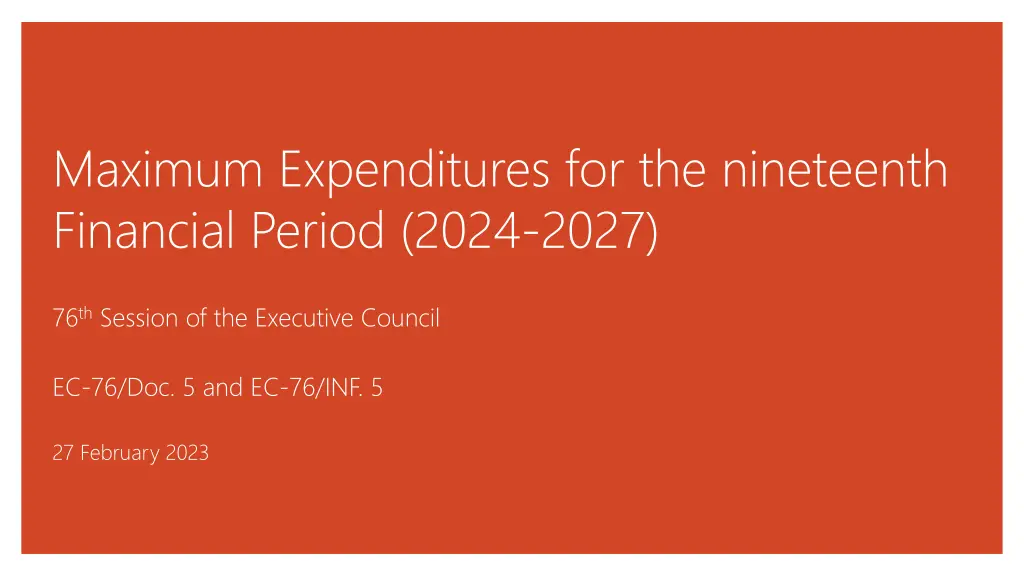


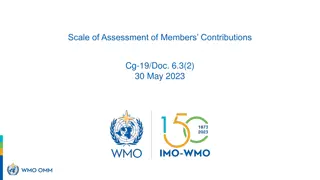










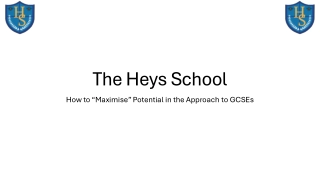

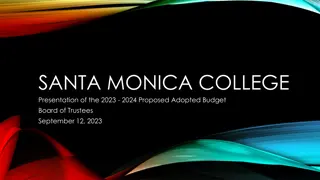









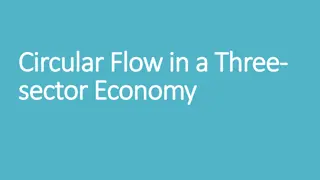
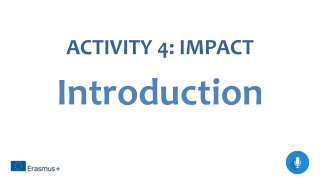


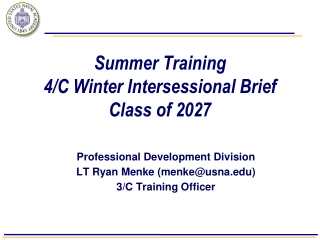




![Financial hardship and the economic burden of health [cancer] care](/thumb/779/financial-hardship-and-the-economic-burden-of-health-cancer-care.jpg)




